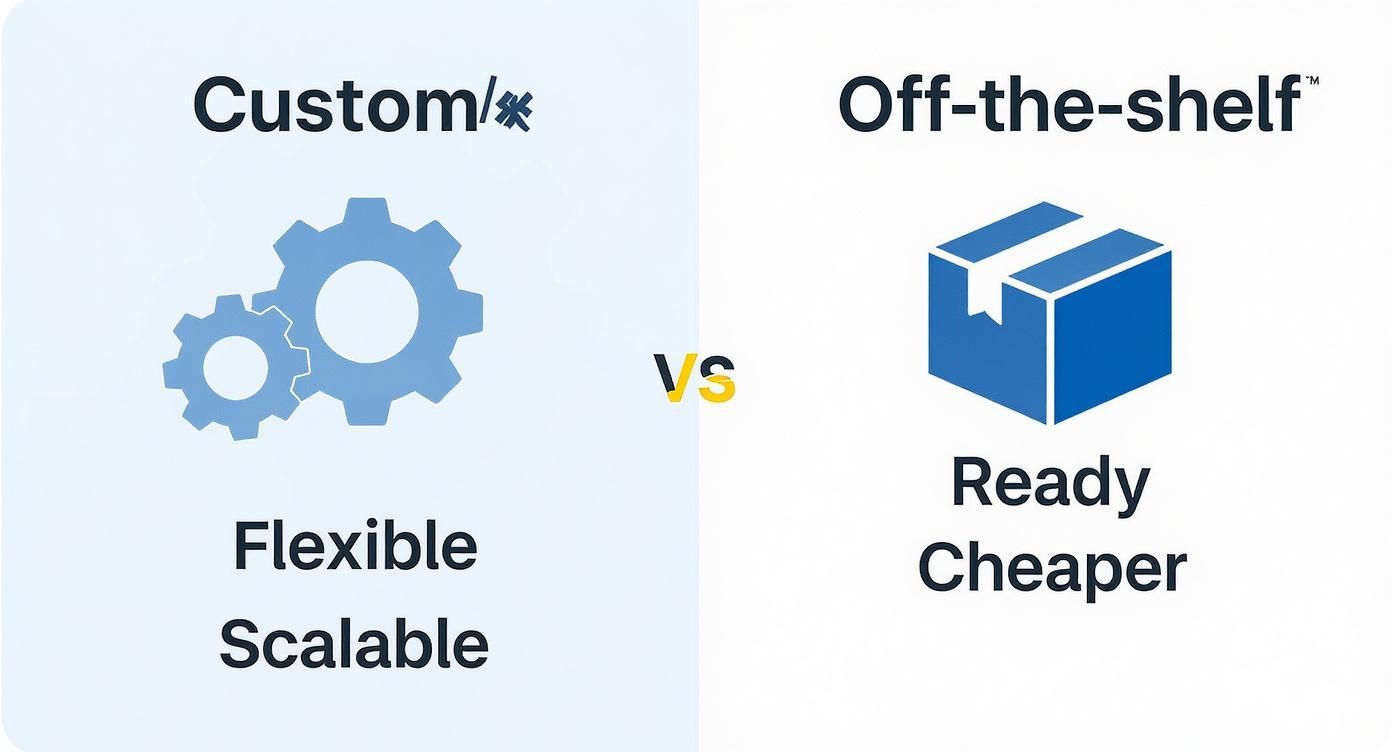When you're looking to build custom software, choosing the right partner is everything. Opting for a team that specialises in custom software development in Toronto means plugging into one of the most dynamic tech hubs in the world. It’s a city where businesses can connect with top-tier teams to create high-quality, scalable digital tools built exactly for them.
Why Toronto Is a Go-To City for Custom Software Development

Think of it like building a championship sports team. You don't just need talented players; you need a great coach, a solid front office, and an environment that pushes everyone to be their best. That’s exactly what Toronto’s tech scene offers – a place where businesses worldwide come to assemble their digital "dream team."
The city has carefully built a winning formula: a massive pool of skilled professionals, a genuinely collaborative community, and a shared drive for innovation. You aren't just hiring coders here. You're gaining access to a complete ecosystem where brilliant strategists, creative designers, and expert project managers all work together.
This unique combination gives any company a serious edge. Projects born in Toronto are shaped by forward-thinking and expert craftsmanship right from the start.
The Power of a Diverse Talent Pool
Toronto's biggest asset is its people. The city is a global magnet for tech talent, attracting seasoned experts and ambitious up-and-comers from all over. This multicultural workforce brings a wealth of different perspectives to the table, which is invaluable for creative problem-solving and true innovation.
The talent here is also incredibly specialised. You can find developers with deep, hands-on experience in just about any field:
-
Artificial Intelligence and Machine Learning: Building smart, adaptive applications.
-
Cloud Computing: Engineering resilient and scalable infrastructure on platforms like AWS and Azure.
-
Fintech: Creating secure and compliant financial technology.
-
SaaS (Software as a Service): Designing robust, subscription-based products ready for a global audience.
It's worth noting that over 30% of Toronto's developer community holds an advanced degree. This high level of academic grounding means they have a firm grasp of complex computer science principles, which translates directly into better-architected, more reliable software.
A Thriving and Collaborative Ecosystem
Beyond the impressive talent, Toronto has a connected and supportive tech community. It's a vibrant mix of scrappy startups, successful scale-ups, global tech giants, and world-class universities all in one place. This concentration of tech-focused organisations creates a powerful cycle of shared knowledge and continuous learning.
This collaborative spirit is key. When you partner with a custom software development Toronto firm, you’re not just getting an isolated team. You’re plugging into a city-wide network where best practices are openly shared, new tech is adopted early, and difficult problems are solved with a collective effort. With over 200 dedicated software firms employing more than 15,000 professionals, the entire city is constantly pushing the envelope.
The proof is in the numbers. The Canadian custom software development market was valued at $2,978.5 million in 2024 and is on track to hit an incredible $9,891.2 million by 2030. Since Toronto makes up over 40% of this market, it's clear the city is the engine driving this growth. You can explore more data about the Canadian software market growth on grandviewresearch.com.
Custom vs Off-the-Shelf Software: What to Choose
Choosing between building custom software and buying an off-the-shelf product is a lot like deciding between a custom-tailored suit and one from a department store. Both get the job done, but one is crafted to fit you perfectly – your measurements, your style, your specific needs, while the other is designed for the average person.
Off-the-shelf software is ready to use right out of the box. It's often a quick, lower-cost fix for common business challenges. The catch? You have to bend your processes to fit the software's limitations. Custom software is the complete opposite; it’s built from the ground up to mirror exactly how you work, giving you a unique tool designed for your success.
This decision is a genuine fork in the road for any growing business. While a pre-packaged solution might seem fine at first, many businesses eventually hit a wall where its rigid structure starts to hold them back instead of helping them move forward.
The Core Differences: Flexibility and Scalability
The single biggest selling point for custom software is its incredible flexibility. Think of your business operations as a detailed blueprint; custom software is engineered to match every single line and angle of that plan. You call the shots on features, workflows, and user experience, which means the tool works for you, not against you.
Ready-made solutions are, by their very nature, rigid. They’re built for a mass market, which means they’re often bloated with features you’ll never touch while missing the specific functions you actually need. Trying to change them is usually either impossible or outrageously expensive, locking you into a system that can’t grow with you.
As your company expands, your software has to keep up. A custom solution is built with your future in mind, designed from day one to handle more users, more data, and new features without buckling under the pressure. For any business looking to gain an edge through custom software development in Toronto, this kind of future-proofing is priceless.
Integration Capabilities and Competitive Advantage
Today’s businesses run on a web of interconnected digital tools. One of the biggest headaches with off-the-shelf products is getting them to play nicely with the other software you already rely on. This often leads to frustrating data silos and time-consuming manual workarounds.
Custom software, on the other hand, is designed for seamless teamwork. It can be built with APIs that let it talk effortlessly with your existing CRM, ERP, or other essential systems, creating a single, efficient workflow. This doesn't just make your team more productive; it gives you one reliable source for all your business data. For a deeper dive, you can explore more about the pros and cons of custom software vs off-the-shelf software in our detailed guide.
Ultimately, custom software gives you a powerful competitive advantage. While your competitors are all stuck using the same generic tools, you have a proprietary solution that perfectly supports your unique processes, boosts efficiency, and lets you deliver a better customer experience. That's how you get ahead and stay there.
Custom Software vs Off-the-Shelf Solutions at a Glance
To make the decision a bit clearer, here’s a straightforward comparison table that lays out how each option stacks up across the most important business factors.
| Attribute | Custom Software | Off-the-Shelf Software |
|---|---|---|
| Functionality | Built precisely for your specific business needs and workflows. | Generic features designed for a broad audience. |
| Flexibility | Highly adaptable and can be modified as your business evolves. | Rigid and difficult, if not impossible, to customise. |
| Integration | Designed to integrate smoothly with your existing software stack. | Often has limited or clunky integration capabilities. |
| Scalability | Built to grow with your business and handle increased demand. | May struggle to scale, requiring costly upgrades or a full replacement. |
| Initial Cost | Higher upfront investment due to development and resources. | Lower initial cost, often based on a subscription model. |
| Long-Term ROI | Higher return through greater efficiency and a competitive edge. | ROI can be limited by ongoing fees and operational bottlenecks. |
| Ownership | You own the intellectual property and the software itself. | You're only licensing the software; you never truly own it. |
This side-by-side view helps highlight the trade-offs. While the initial sticker price of custom software is higher, the long-term value it delivers in efficiency, scalability, and competitive positioning often makes it the smarter investment for ambitious businesses.
Navigating the Software Development Lifecycle
Think of building custom software like constructing a custom home. You wouldn’t just show up with a pile of lumber and start hammering. You need an architect, a detailed blueprint, and a clear plan for every single phase, from laying the foundation to picking out the final fixtures. The Software Development Lifecycle (SDLC) is that blueprint for your digital product, guiding your project from a back-of-the-napkin idea to a fully functioning application.
In Toronto’s dynamic tech scene, this process needs to be both structured and adaptable. It’s a roadmap designed to wrangle complexity, minimise surprises, and deliver a final product that actually solves your business problem. To get a handle on your project, it’s worth understanding the phases of the software development process, which provide a clear, systematic path from start to finish.
Stage 1: Discovery and Strategy
Every great project starts with a conversation. This is the discovery phase, and it’s arguably the most important step. Your development partner essentially becomes a business consultant, digging deep to truly understand your company, your customers, and the challenges you’re trying to overcome. This means stakeholder interviews, market research, and a hard look at what your competitors are doing.
The main goal here is to create a solid project roadmap. This document isn't just a wish list; it defines the scope, outlines the core features for a Minimum Viable Product (MVP), and sets realistic timelines and budgets. Nailing this stage prevents expensive detours later and ensures everyone is working towards the same goal.
Stage 2: UI/UX Design
Once you know what you’re building, it’s time to figure out how it should look and feel. The User Interface (UI) and User Experience (UX) design phase is where logic meets creativity. It’s all about crafting a product that’s not just powerful on the inside but also intuitive and genuinely pleasant to use on the outside.
This stage usually breaks down into a few key activities:
-
Wireframing: Think of this as the basic architectural sketch of your app, mapping out where everything goes and how users will navigate from one screen to another.
-
Prototyping: This brings the wireframes to life. You get interactive mockups that let you click around and get a real feel for the software before a single line of code is written.
-
Visual Design: Here, the designers apply your branding, colour palette, and typography to create a polished, professional look that feels like your product.
A sharp focus on UI/UX is a non-negotiable for top-tier custom software development in Toronto. It's what makes the difference between the software people have to use and the software they want to use.
Stage 3: Development and Coding
With the blueprint and design locked in, the real construction begins. This is the development phase, where engineers get to work writing the code that brings your vision to life. The entire project is usually broken down into smaller, two-to-four-week chunks of work called "sprints" – a core principle of the Agile methodology.
This flexible approach is incredibly common across Toronto’s tech sector. In fact, over 63% of organisations in the city use Agile frameworks because they allow for quick pivots and continuous improvement. It’s a fast-moving environment where more than 40% of firms are building in AI-driven features and many more are focusing on cloud-native solutions.
Agile development means you’re not left waiting for months to see a finished product. Instead, you see tangible progress in short cycles, giving you plenty of opportunities to offer feedback and make course corrections along the way.
Stage 4: Quality Assurance and Testing
Before your software is ready for the spotlight, it has to go through a rigorous boot camp. The Quality Assurance (QA) phase is all about hunting down bugs, spotting performance bottlenecks, and making sure the application is secure and reliable. It’s a critical stress test.
Testers put the software through its paces with a whole battery of checks, including:
-
Functional Testing: Does every button, form, and feature do exactly what it’s supposed to do?
-
Performance Testing: How does the app hold up when a lot of people are using it at once?
-
Security Testing: Are there any weak spots or vulnerabilities that could be exploited?
This painstaking process ensures the software you receive is stable, robust, and ready for whatever your users throw at it. It’s about protecting your investment and your reputation.
Stage 5: Deployment and Maintenance
This is the big moment – launch day. Deployment is when the fully tested and approved software is released into the wild for your users. But the work doesn’t stop there. Just like a new car, your software needs ongoing maintenance to keep it running smoothly. This includes regular updates, security patches, performance monitoring, and eventually, adding new features based on user feedback.
Getting a handle on the entire journey is key. For more on this, you can dig into our guide on creating a realistic software development timeline.
This infographic offers a great side-by-side look at the custom software path versus buying something off-the-shelf.

As you can see, while pre-packaged software gets you started quickly, a custom solution is built to adapt and scale right alongside your business, giving you the flexibility you need for long-term growth.
How to Budget for Your Toronto Software Project
Talking about money can feel like you're walking on eggshells, but it doesn't have to be that way. Setting a budget for a custom software project in Toronto is one of the most important first steps you'll take. The goal isn't just to find the cheapest price, but to really get a handle on what drives the cost. When you understand the "why" behind the numbers, you can invest smartly and build something that delivers real, lasting value.
I like to compare it to building a custom home. The final cost depends on the size of the lot, the complexity of the architectural plans, the experience of the builder, and the quality of the materials. A simple bungalow is a world away from a multi-level home with high-end finishes. In the same way, your software's price tag is a direct reflection of what you need it to do and how well you want it built.
Deconstructing the Costs
The quote you get for a custom software project isn't just a number pulled out of thin air. It’s a thoughtful calculation based on the time, skill, and resources needed to bring your idea to life. Let’s pull back the curtain on the main cost drivers you’ll see when working with a Toronto-based team.
These key pieces all fit together to determine your project's final cost:
-
Project Complexity and Scope: This is the big one. A simple, informational website with a few static pages is one thing. But an e-commerce platform with live inventory management, a secure customer portal, and multiple payment gateway integrations? That's a much bigger beast. The more features you add and the more complex the business logic, the more development hours it's going to take.
-
The Technology Stack: The specific programming languages, frameworks, and databases used can also shift the price. Some technologies demand developers with very specialised, and often more expensive, skill sets. For example, a solution built on advanced artificial intelligence or blockchain technology will naturally require a higher budget than one using more common tools.
-
Team Composition: Who is actually building your software? The size and experience of the development team are huge factors. A senior-led team from a top Toronto agency will command a higher hourly rate than a group of junior developers. But here's the kicker: their efficiency, problem-solving skills, and ability to sidestep common issues often result in a better final product and a lower total cost over the long run. You're paying for their expertise to get it right the first time.
-
UI/UX Design Intricacy: A basic, functional design is quicker and cheaper to build than a slick, custom-animated user interface. A world-class user experience is non-negotiable for most modern apps, but achieving it takes more time from talented designers and front-end developers, which gets factored into the budget.
Understanding Realistic Cost Ranges
The market for custom software development in Toronto is vibrant and competitive, which is a good reflection of the city's incredible talent pool. Current research shows that the average cost for a custom software project in Canada can fall anywhere between $20,000 and $50,000, with Toronto agencies often sitting at the higher end of that spectrum. For larger, more complex, enterprise-level systems, that figure can easily climb north of $200,000. For a deeper dive into these numbers, you can check out a detailed cost analysis for Canadian software development on nectarbits.ca.
Remember, a quote is more than just a number. It’s a reflection of the agency's process, quality, and commitment to your project. A bid that seems too good to be true probably is; it could signal cut corners, inexperienced developers, or a fundamental misunderstanding of your needs, which often leads to expensive fixes later on.
Investing in a well-built solution from a seasoned team isn't an expense; it's a strategic move. It ensures your software is not just working today, but is also secure, ready to scale, and easy to maintain for years to come. That proactive approach will save you a ton of money and headaches down the road, making it a much smarter investment than just going with the lowest initial bid.
Choosing the Right Toronto Development Partner

Picking a partner for your custom software development in Toronto is one of the most critical business decisions you'll make. This isn't just about hiring a supplier; it's about finding a co-architect for your company's future. The right team becomes a true extension of your own, deeply invested in your success and ready to transform your vision into a real, high-functioning asset.
The tricky part? Toronto is buzzing with talented firms, and at first glance, many of them can seem interchangeable. To find the one that’s genuinely right for you, you have to look past the slick portfolios and convincing sales pitches. You need a clear process to evaluate their technical chops, their project management discipline, and, just as crucial, their company culture.
This means asking the tough questions. A truly great partner doesn’t just build what you tell them to. They challenge your assumptions, suggest smarter ways to get things done, and help you steer clear of potential roadblocks you didn't even know were there.
Assessing Technical Capabilities and Industry Expertise
First things first: you need to be sure they have the technical horsepower to get the job done right. A strong portfolio is a good starting point, but you need to dig deeper to see if their expertise truly matches your project’s specific needs.
Don't be shy. Ask them about their direct experience with the technology stack you have in mind or how they'd approach your most complex architectural challenges.
It’s also a huge advantage to find a team with proven experience in your sector. A firm that’s built fintech apps will already be up to speed on security and compliance hurdles. One with a healthcare background will know the ins and outs of privacy regulations like PHIPA. This kind of specialised knowledge can save you an incredible amount of time and help you avoid expensive missteps.
Here's what to investigate:
-
Technology Stack Proficiency: Do they have senior-level experts in the specific languages and frameworks your project will be built on?
-
Scalability and Performance: Ask for concrete examples of applications they've built that were designed to handle major user growth and heavy data loads.
-
Security Practices: How do they bake security into their process? Ask about their coding standards, vulnerability testing, and data protection protocols.
Evaluating Project Management and Communication Styles
A team of brilliant coders is almost useless without excellent project management and crystal-clear communication. This is the operational glue that holds everything together, keeping your project on time and on budget. Remember, you're not just buying lines of code; you're investing in a process.
Pay close attention to how they communicate. It's a dead giveaway for how the partnership will work. Do they provide regular, structured updates? Who is your dedicated point of contact? A predictable communication rhythm is key to preventing misunderstandings and ensuring you always know where things stand.
Your development partner should be a proactive communicator, not a reactive order-taker. Look for a team that sets clear expectations, provides honest feedback, and is transparent about challenges as soon as they arise. This builds the trust necessary for a successful long-term relationship.
Finding the Right Cultural Fit
Finally, never underestimate the power of a good cultural fit. You’ll be working side-by-side with this team for months, maybe longer, so a compatible working style is non-negotiable. A clash in values or work ethic can create friction that sinks even the most meticulously planned project.
Are you looking for a formal, highly structured agency, or would you prefer a more agile, collaborative group? During your initial chats, notice how they answer your questions. Do they seem genuinely curious about your business and your goals?
For more great advice on this crucial step, check out these 10 simple tips to choose the right software development company. Ultimately, finding a partner who shares your commitment and passion is what will allow you to build something truly exceptional together.
Your Top Questions About Toronto Software Development, Answered
Stepping into the world of custom software can feel a little daunting. Even with a solid idea, you're bound to have questions. This section cuts through the noise and gives you straight, practical answers to the most common things business leaders ask about custom software development in Toronto.
Think of this as the final conversation before you kick things off, clearing up any last-minute uncertainties about timelines, ownership, and what happens after the big launch.
How Long Will My Project Actually Take?
This is usually the first question on everyone's mind, and the honest answer is: it depends entirely on what you're building. There’s no cookie-cutter timeline when you’re creating something from the ground up.
A great way to picture it is to think about construction. Are you building a simple, elegant tiny home or a sprawling commercial skyscraper? A focused Minimum Viable Product (MVP) with just the essential features can often be designed, built, and launched in as little as 3-4 months. This is a fantastic way to get your idea into the market quickly and start gathering real-world feedback.
On the other hand, a complex, enterprise-level system with sophisticated security, multiple third-party integrations, and deep business logic will naturally take longer. A project of that scale could easily be in development for 9-12 months or more. These larger builds require meticulous planning and rigorous testing to make sure every single piece works together flawlessly.
The good news? The best Toronto development teams work in an agile way. You won't be left waiting for a "big reveal" at the very end. The project is broken down into small, manageable "sprints," where you get to see and test functional pieces of your software every few weeks. This keeps you in the loop and allows you to give feedback every step of the way.
Who Owns the Code and Designs?
This is a big one, and the answer should be crystal clear: you do. When you pay a firm to build custom software, you should own 100% of the intellectual property (IP). This is the standard, non-negotiable practice for any reputable agency.
Once the project is complete and the final invoice is settled, everything created should be handed over to you. That includes:
-
The source code: The entire DNA of your application.
-
All design files: Every wireframe, mockup, icon, and visual element.
-
Databases and documentation: The full architecture and any guides for using or updating it.
Make sure this is spelt out explicitly in your contract before a single line of code is written. A trustworthy Toronto partner will have this as a standard clause in their agreement. There should be absolutely no grey area here. Your software is your business asset, and you need to have full control over it.
What Happens After My Software Is Launched?
The launch isn't the finish line; it's the starting pistol. Just like a brand-new car needs regular maintenance to run smoothly, your software needs ongoing care to stay secure, fast, and effective. Any top-tier firm offering custom software development in Toronto knows this and will have a plan for post-launch support.
This is usually managed through a dedicated maintenance plan or a Service Level Agreement (SLA). The whole point of these agreements is to protect your investment and keep your application in peak condition.
Typically, this support covers:
-
Bug Fixes: Stamping out any unexpected technical issues that pop up.
-
Security Updates: Applying the latest patches to shield your software from emerging threats.
-
Performance Monitoring: Watching over server health and application speed to catch problems before they cause downtime.
-
Feature Enhancements: Strategically adding new capabilities based on user feedback and your evolving business goals.
This ongoing partnership ensures your software doesn't just launch; it thrives.
Can We Work with a Toronto Team if Our Business Is Located Elsewhere?
Absolutely. In fact, it's more common than you might think. Toronto's tech scene has a stellar global reputation, and its development firms are experts at collaborating with clients all over the world. Modern tools have made geography almost irrelevant.
Toronto-based teams are masters of remote work. They live and breathe on platforms like Slack for quick chats, use tools like Jira to keep projects transparent and on track, and rely on video calls to stay perfectly aligned with you, no matter the time zone difference. Their entire workflow is built for this kind of collaboration, so your physical location won't be a barrier to success.
Ready to build a solution that drives your business forward? Cleffex Digital Ltd specialises in creating powerful, scalable custom software for businesses of all sizes. Let's discuss your vision and turn it into a reality.








